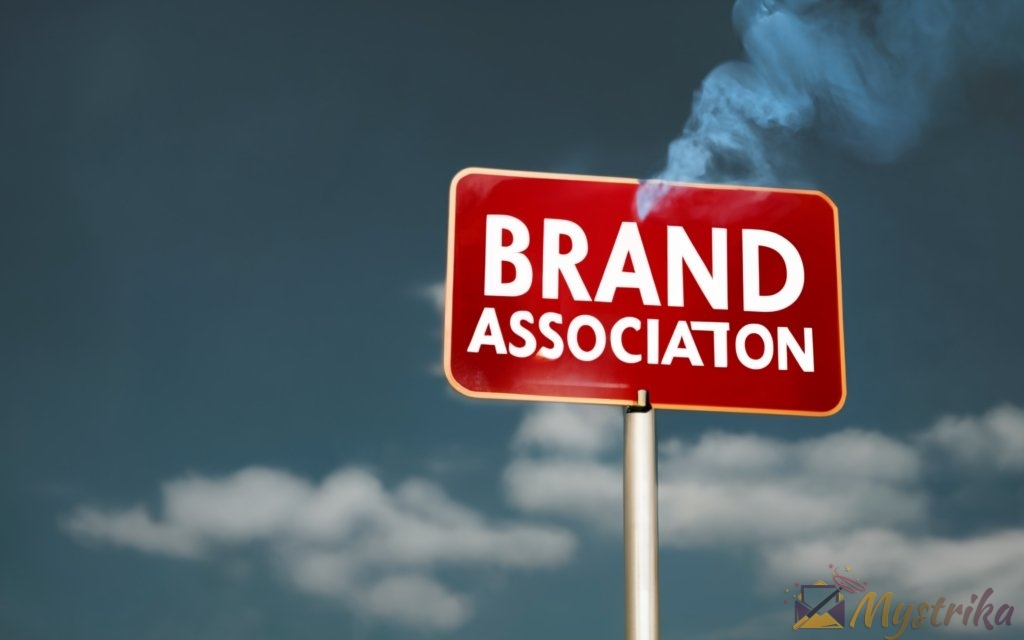What pops into your mind when you hear Apple? Innovation and premium design, most likely. What about Coca-Cola? Refreshment and togetherness. Brand associations make some companies unforgettable.
Discover what brand association really means and why these subconscious connections hold enormous influence over marketing success. This complete guide examines how associations form, types and examples, and how to strategically build associations that attract your ideal customers.
What is Brand Association?
Brand association refers to the connections and relationships that consumers mentally make with a brand. In other words, it’s what comes to mind when someone thinks of your company or product.
These associations heavily influence consumer behavior and purchasing decisions. When people hear your brand name, you want positive thoughts, emotions, perceptions, and experiences popping into their heads.
Brand Association Definition
More formally, a brand association is defined as:
A mental connection between a brand and a concept, image, emotion, perception, or experience held in the consumer’s memory.
These concepts can include sensory elements like colors, smells, sounds, textures, and more abstract associations like innovation, luxury, reliability, or environmental friendliness.
Brand association helps consumers recall and recognize your brand faster. It’s the reason why when you say “search engine” most people instantly think Google or when you say “soda” they think Coke or Pepsi.
How Brand Associations Work
Brand associations form in a consumer’s mind through repeated exposure and interactions with your brand. This happens both consciously and subconsciously.
For example, if you consistently deliver high-quality products with excellent customer service, consumers will start associating your company with reliability, trustworthiness, and satisfaction.
Every touchpoint along the buyer’s journey presents an opportunity to shape brand associations, including:
- Advertising campaigns
- Social media engagement
- Product packaging
- Online reviews
- Retail store experiences
- Customer service interactions
- Word-of-mouth referrals
The more touchpoints where consumers have positive experiences with your brand, the stronger the mental associations become.
Brand associations can also form indirectly through things like:
- Celebrity sponsors and endorsements
- Cultural trends and media
- Charity partnerships and cause marketing
- Product placement in movies and TV shows
For example, Nike’s brand has long been associated with Michael Jordan. So even consumers who have never purchased Nike products associate the brand with elite athletic performance, competitiveness, and achievement.
Types of Brand Associations
There are many kinds of brand associations consumers make, but some common categories include:
Attribute-based
Associations related to product attributes like quality, price, design, durability, taste, effectiveness, social responsibility, and more.
Benefit-based
Associations related to functional, emotional, and social benefits consumers receive from using your product/service.
Interest-based
Associations related to hobbies, passions, values, and aspirations your brand aligns with.
Personality-based
Associations related to celebrities, influencers, brand mascots, or anthropomorphized brand personalities.
Attitude-based
Associations related to underlying emotions, beliefs, causes, lifestyles, and attitudes your brand embodies.
Experiential
Associations related to sensory elements like textures, smells, sounds, tastes, and how consumers physically experience your brand.
Measuring Brand Associations
There are a few techniques used to measure brand associations quantitatively:
- Brand association maps: Visual diagrams showing consumer perceptions of brand attributes and benefits.
- Free association tests: Consumers freely voice top-of-mind brand associations which are tallied.
- Projective techniques: Consumers are shown an image, phrase or scenario involving the brand and asked to interpret it.
- Association pickup tests: Consumers react to a brand name being stated; biometric sensors detect emotional reactions.
Qualitative research like focus groups and interviews also provides insights into brand associations. The goal is identifying patterns in the descriptive concepts consumers link back to your brand.
Tracking brand associations over time shows how marketing efforts strengthen or weaken different associations. It also alerts you to any negative associations that may be forming.
Now that you understand the psychology behind brand associations, let’s look at why they are so crucial for branding success.
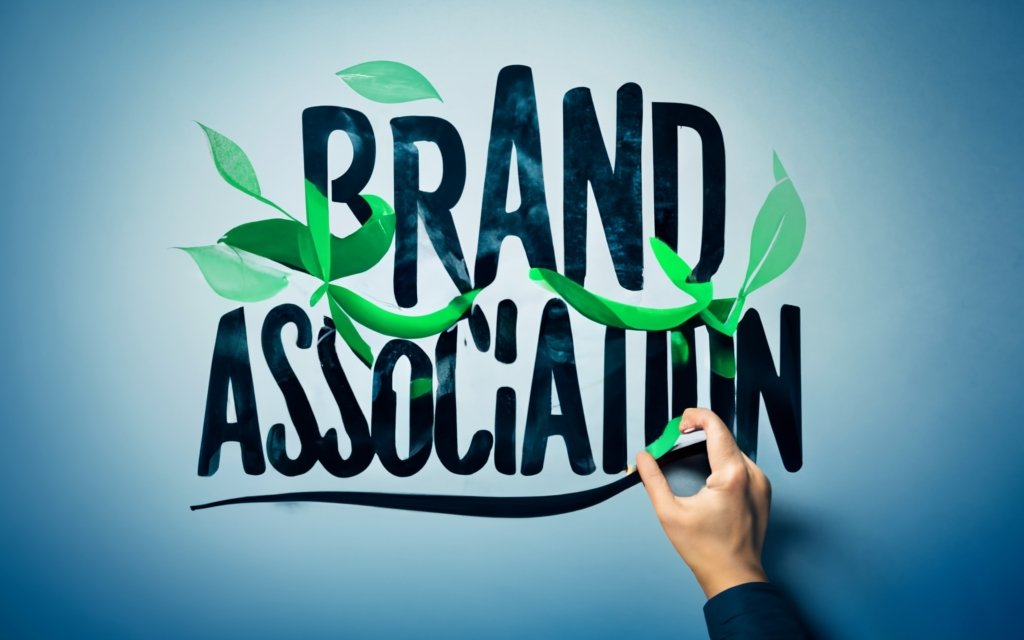
Why is Brand Association Important?
Brand associations are crucial in shaping how consumers perceive and engage with your brand. The associations people have with your brand can determine its success or failure.
Here are 5 key reasons why managing brand associations should be a priority:
1. Increases Brand Awareness
Brand awareness refers to how easily consumers can recall and recognize your brand. Brands with strong awareness pop into consumers’ minds faster when they think about a particular product category or need.
Powerful and unique brand associations are key drivers of awareness. Distinctive attributes get your brand noticed and remembered more easily.
For example, when most people think of package delivery services, FedEx is one of the first brands that comes to mind. FedEx spent years promoting itself as an ultra-reliable and speedy shipping company. So those positive associations became ingrained in consumers’ minds, leading to top-of-mind awareness.
2. Builds Brand Loyalty
Loyal customers repeatedly choose to engage with your brand over competitors. Brand associations heavily influence loyalty by creating meaningful connections and relationships between consumers and brands.
When consumers have positive experiences and associate feelings of happiness, satisfaction, or social belonging with your brand, they are more likely to become lifelong customers.
Starbucks, for instance, doesn’t just sell coffee. It sells an experience people associate with taking a relaxing break, connecting with friends, and reward treats. Those emotional and experiential associations convert one-time shoppers into loyal regulars.
3. Differentiates Your Brand
Brand associations are key to differentiation – setting your brand apart from competitors. You want to own clear associations in consumers’ minds that no other brand can claim.
For example, Volvo dominates the association between vehicle brands and safety. BMW commands the association with high-performance driving. And Toyota owns dependability.
Owning distinct associations makes choosing between brands easier for consumers. They can quickly narrow down options based on the associations each brand has carved out.
4. Drives Purchase Decisions
Brand associations directly impact purchase behavior. When consumers have positive interactions with your brand, they are more likely to consider and choose your product.
This happens because of the implicit expectations formed based on brand associations. If Dove is strongly associated with mildness and gentleness, consumers assume Dove soap will be gentle on sensitive skin.
And when consumers think of a particular category like athletic shoes, the brand most highly associated with performance, style, or cutting-edge technology will have an advantage.
5. Creates Positive Brand Image
Your brand image is the sum total of perceptions, impressions, and associations consumers have about your brand. So brand associations directly feed into how your brand image develops.
Brands with strong, favorable associations like quality, innovation, and social responsibility have highly positive brand images. Consumers view these brands as market leaders and premium choices.
Whereas brands with negative associations can tarnish brand image. For example, a technology company associated with privacy violations and data breaches will have a severely damaged reputation.
Brand Associations Influence Decision Making
Brand associations hold power because consumers use them as mental shortcuts for decision making. They don’t have time to rigorously evaluate every brand and product. So they rely on the associations already stored in their memory.
For example, say you had a headache and wanted fast relief. If you had positive past experiences with Advil working quickly, you’d likely reach for Advil instead of evaluating every headache medicine on the shelf. Your existing association with effectiveness would drive your choice.
Brand associations also create expectations that influence satisfaction. If you expected a luxury hotel to have exceptional service based on associations with other luxury hotels you’ve stayed at, anything less would lead to disappointment.
Negative vs. Positive Brand Associations
Obviously, you want to develop only positive associations for your brand in consumers’ minds. But negative associations can form too:
- Attribute-based e.g., low quality, overpriced, unreliable
- Interest-based e.g., outdated, boring, meant for older consumers
- Attitude-based e.g., unethical, deceptive, uncaring
- Experiential e.g., confusing, frustrating, time-consuming
Negative associations need to be proactively monitored and managed before they spread. If many consumers have a poor product experience or hear negative buzz, it can quickly tarnish your brand image.
Rehabilitating negative associations takes time and concentrated effort across all brand touchpoints. But it is possible. Brands like Domino’s and Ford successfully overcame past negative associations with marketing campaigns focused on reinventing themselves.
Brand Associations Must Evolve With Customers
Keep in mind brand associations are not static. They can and must evolve as consumer values, priorities, and trends evolve.
For example, CEOs and social media teams can’t just make tone-deaf statements and expect brand loyalty to prevail. Consumers today care deeply about brand values and integrity.
Younger generations also want brands that understand issues like sustainability, diversity, and mental health. Brands that fail to adapt their associations risk declining relevance.
Proactively shaping brand associations based on what resonates with your target audience is what builds an enduring, authentic brand image.
Measuring and Tracking Brand Associations
Given the importance of brand associations, you need to actively track them by:
- Conducting market research surveys with open-ended association questions
- Monitoring social listening data for word associations mentioned
- Analyzing reviews and community comments for common themes
- Running free word association tests with consumers
- Building brand association maps to visualize perceptions
Look for overlaps in the descriptions consumers use for your brand. Group these associations into bigger buckets like personality, values, benefits, and attributes.
Compare results against your desired brand identity and positioning. Look for gaps between actual consumer perceptions versus brand goals.
Continuously measure associations before and after major marketing campaigns or brand incidents. This quantifies their impact on shaping associations.
Ongoing brand tracking provides early warning signs of negative associations forming. Most importantly, it confirms which associations resonate most powerfully with your audience.

Types of Brand Associations
Brand associations fall into different categories based on the types of concepts and connections formed in consumers’ minds. Some common categories include:
Attribute-Based Brand Associations
These associations relate to the descriptive features and characteristics of a brand’s products or services. Attribute associations help consumers recall what a brand offers and why it might be useful to them.
Common types of attribute associations include:
Quality
One of the most sought-after associations is with high quality. When consumers associate a brand with durability, longevity, craftsmanship, or premium materials, it signals a higher-value product.
Brands like Rolex watches and Mercedes cars have built strong quality associations through multi-generational craftsmanship and flawless performance.
Reliability
Closely tied to quality is reliability. Dependable brands that consumers can trust to consistently deliver on their promises tend to dominate their product categories.
For example, FedEx’s early reputation for on-time delivery and package tracking helped it become consumers’ most trusted shipping provider.
Innovativeness
Brands that push boundaries with inventive thinking tend to be seen as industry leaders. They get credit for advancing capabilities and uses for consumers.
Apple has long held an undisputed association with being an innovator given its track record of groundbreaking devices like the iPod, iPhone, and Apple Watch.
Credibility & Trustworthiness
Trust is hard-earned but easily broken. Brands that demonstrate honest business practices and keep customers’ best interests in mind are rewarded with credibility associations.
Burt’s Bees is a great example of a brand associated with natural ingredients and ethical production standards.
Value for Money
Retail brands especially can benefit from associations with affordability, deals, bargains, and overall value. It appeals to price-conscious shoppers.
For example, Walmart has built an empire around its ability to maintain an association with everyday low prices.
Sustainability & Social Impact
Today’s consumers care deeply about social and environmental issues. Brands get credit for associations with sustainability, ethical sourcing, charitable giving, and other CSR efforts.
Brands like Patagonia and Toms Shoes have baked these associations into their business models.
Packaging & Visual Identity
Packaging plays a big role in forming consumer impressions. Distinctive shapes, colors, labeling, fonts, and materials build recognition.
Coca-Cola’s contoured bottle and Spencerian script logo are prime examples of memorable visual brand associations.
Benefit-Based Brand Associations
These associations connect the brand to the functional, emotional, and social benefits users get from the product/service.
Functional Benefits
This refers to how effectively the product performs its intended purpose. Fast relief, stain removal, energy boosts, productivity software, and vehicle horsepower are functional promises brands make.
Head & Shoulders is strongly tied to the benefit of relieving dandruff. Its active ingredient (pyrithione zinc) dominates associations.
Emotional Benefits
Brands also build associations with feelings or emotional states their product creates. Feelings of indulgence, relaxation, confidence, luxury, and being cared for are examples.
Häagen-Dazs ice cream relies heavily on associations with indulgence and sensual pleasure to differentiate.
Social Benefits
Consumers are drawn to brands that align with their ethics. Cause marketing and social responsibility associations reflect positively on brands.
Toms Shoes built its brand around the feel-good benefit of donating a pair of shoes for every pair sold.
Interest-Based Brand Associations
These associations tap into consumers’ core passions, values, and aspirations. Brands align themselves with interests their audience cares about.
Passion Points & Hobbies
Brands that associate themselves with consumers’ personal pastimes and passions earn deeper connections.
Red Bull’s association with extreme sports like motocross, surfing, and skateboarding is a perfect example.
Values & Causes
Brands that support bigger causes draw ideologically-aligned consumers. Patagonia and The Body Shop built brands around environmentalism and social justice respectively.
Aspirations & Lifestyles
The lifestyles and aspirations consumers hold appeal are used by brands to capture interest. Luxury cars connect to desires for status and sophistication. Outdoor brands tap into aspirations of adventure and escaping reality.
Escapism & Adventure
Brands like Royal Caribbean cruise lines evoke associations with relaxation, discovery, and exotic destinations. These appeal to people’s need for escape and experiences.
New Experiences
Some brands excite consumers with associations involving exploration, learning, and embracing new experiences. Google and Airbnb capture associations with discovery and expanding boundaries.
Personality-Based Brand Associations
These associations involve assigning human-like characteristics or third-party endorsements. This allows consumers to relate to brands like they would to a friend.
Celebrity Endorsements
Pairing brands with well-liked and relevant celebrities taps into their likability. Brands bask in the halo effect of positive associations already held with celebrities.
Pepsi has long used major popstars like Michael Jackson, Britney Spears, and Beyonce in ads to absorb their cool, youthful energy.
Influencer Marketing
Microinfluencers and bloggers with loyal niche followings also create personality associations. Their stamp of approval carries weight with their tribes.
Outdoorsy brands like Cotopaxi and Chacos use influencer endorsements from major adventurers and national park advocates.
Brand Mascots
Mascots allow brands to literally create a face for their name that builds recognition. These brand characters often get involved in culture as spokespeople.
KFC’s Colonel Sanders, the Energizer Bunny, and the Kool-Aid Man are examples of iconic mascots.
Anthropomorphizing
Beyond mascots, brands build unique personalities by speaking directly to consumers and ascribing human traits or voices to their brand.
Dollar Shave Club uses a cheeky, no-nonsense voice in its videos to win over subscribers. Mailchimp’s branding displays a fun, friendly chimp character sending emails.
Attitude-Based Brand Associations
These associations tap into the mindsets, worldviews, and attitudes consumers respond to. Brands align with particular subcultures, values, and priorities.
Values & Causes
Brands that openly advocate for causes gain admiration from consumers who share those values. Patagonia and Ben & Jerry’s have built brands around activism.
Counterculture
Some brands feed off associations with going against the grain. They appeal to subsets of consumers who admire rule-breaking irreverence.
Harley-Davidson has long embodied the outlaw biker attitude with associations of ruggedness and rebelliousness.
Political & Social Views
Brands are increasingly being pulled into national conversations about social and political issues. Their stance makes them heroes or villains.
Nike’s branding has boldly aligned with outspoken athletes protesting racial injustice, riling up some consumers but winning loyalty among progressives.
Luxury & Materialism
For high-end brands, associations with exclusivity, luxury, and fine-living create strong appeal among affluent consumers.
Mercedes-Benz draws upon associations with German sophistication and elite status.
Laid Back Culture
Surfing, skating, hip-hop, and other laidback subcultures offer branding opportunities around free-living attitudes.
Vans shoes powerfully aligns itself with creative street culture and hip expressions of individualism.
As you can see, the possibilities for brand associations are endless. The key is identifying associations that will authentically resonate with your target audience and maximally differentiate you from competitors.
Next let’s look at examples of brands that have built powerful associations in consumers’ minds.
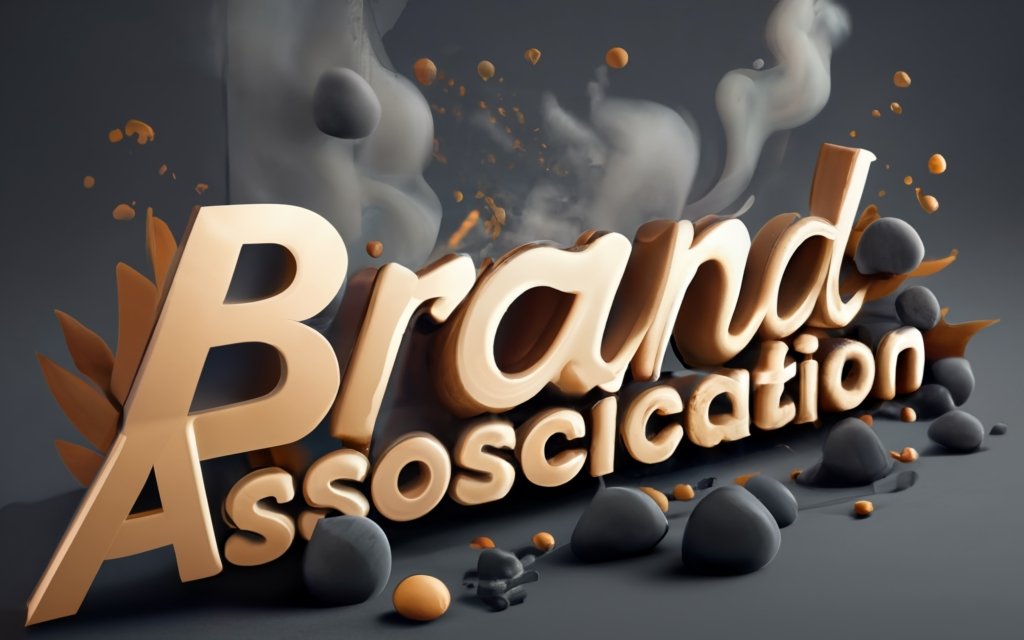
Examples of Powerful Brand Associations
Let’s look at a few stellar examples of brands that have cultivated strong, positive associations that catapulted them to success:
Apple
This tech giant has built a reputation for:
- Innovation – Apple is constantly pushing boundaries. The iPod, iPhone, iPad, and Apple Watch completely transformed their product categories. Consumers eagerly await the next big thing from Apple.
- Design – Apple’s aesthetically pleasing product designs in clean white/silver and sleek black exude simplicity and sophistication. The glowing Apple logo is instantly recognizable.
- Quality – From the hardware to software, Apple’s products just work. They’re known for premium materials, detailed craftsmanship, and “it just works” usability.
- Premium positioning – Priced higher than competitors, Apple maintains a prestigious brand image. Owning the latest devices projects an image of affluence and being tech-forward.
- Creativity – Apple’s bold vision empowers people to unleash creativity and passion projects. Its suite of creative professional apps appeals strongly to artists and photographers.
- User experience – Apple maniacally focuses on creating intuitive, frictionless experiences customers love interacting with daily. Its brand promise is around enhancing peoples’ lives through technology.
Nike
Nike dominates sports apparel with associations of:
- Performance – Nike shoes and apparel are well-known for aiding athletic performance. Products are tech-forward and designed for sport specificity.
- Motivation – The iconic “Just Do It” tagline encapsulates Nike’s inspirational call to push limits physically and mentally. It aligns athletics with overcoming challenges.
- Competition – Sponsorship of elite athletes and sports teams contributes to Nike’s competitive associations. Consumers wear Nike gear to feel like champions.
- Innovation – Nike consistently raises the bar, like introducing Nike Air cushioning or Flyknit construction. Consumers turn to Nike for cutting-edge sportswear.
- Style – On and off the field, Nike defines what’s trendy. Young sneakerheads obsess over the latest Nike drops. The Swoosh logo alone screams cool streetstyle.
- Social conscience – By taking stands on issues like the environment and racial justice, Nike’s brand appeals to conscientious consumers.
Coca-Cola
This iconic soda brand is recognized for associations like:
- Happiness – Coke’s feel-good messaging always links its products to smiling faces, uplifting music, and cheerful moments. Drinking Coke is forever tied to joy.
- Togetherness – Coca-Cola commercials tend to feature people coming together, enjoying each other’s company, and creating memories over a Coke.
- Americana – As an original American brand, Coca-Cola’s red cans lined up at a picnic scream 4th of July Americana. It’s a historic slice of American culture.
- Refreshment – The ice-cold fizziness and energizing caffeine gives Coke strong associations with being the perfect break-time refreshment.
- Universal appeal – Enjoyed by every age, race, and nationality, Coke maintains a broad appeal and accessibility that feels welcoming to all.
- Nostalgia – With roots dating back to 1886, Coke prompts fond memories across generations of decades past. First dates, road trips, childhood – it’s been there for life’s special moments.
Patagonia
This outdoor apparel brand has cultivated eco-conscious associations:
- Sustainability – Patagonia is recognized as a pioneer of corporate environmental stewardship and responsibility. Its messaging consistently promotes green values.
- Environmental protection – The brand financially backs many initiatives to conserve and rehabilitate threatened natural spaces. Consumers spread awareness by wearing Patagonia gear.
- Minimalism – Patagonia’s simple, utilitarian product designs avoid excess and waste. The durability helps prevent quick disposal and champions simplicity.
- Ethical manufacturing – By vetting its factories and supply chain for fair labor practices, Patagonia supports ethics and human rights.
- Activism – Sponsoring grassroots activists and advancing policy change links Patagonia to civic engagement. Brand devotees feel part of a bigger cause.
- Workmanship – Premium quality, durable construction, and timeless style offer great value. Their products inspire confidence for outdoor pursuits.
These positive associations all align seamlessly with Patagonia’s mission and values. Their brand story packs a powerful punch.
Now that you’ve seen how top brands link themselves in consumers’ minds, let’s discuss how you can proactively shape positive associations.
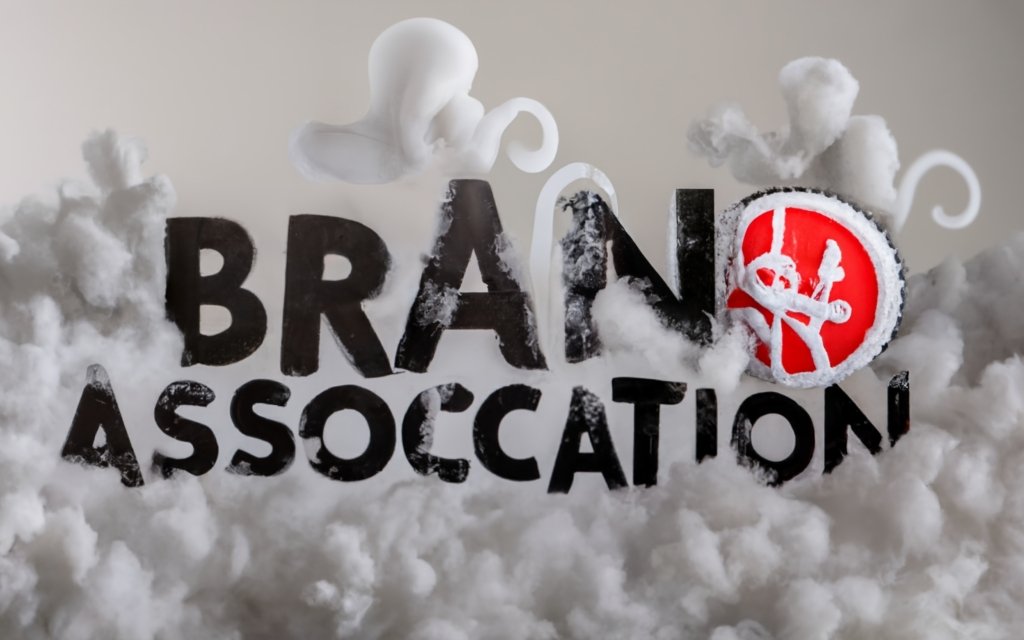
How to Create Strong Brand Associations
Creating strategic, positive brand associations takes considerable time and effort. But it’s an investment that pays dividends in building brand equity and loyalty. Here are some best practices:
1. Identify Your Brand Personality and Values
Get crystal clear on your brand identity and what makes your business unique. Map out the personality traits, values, quirks, and distinguishing elements that you want your brand to embody.
These should guide the types of associations you proactively shape through all touchpoints. Stay true to who your brand authentically is at its core.
2. Ensure Consistent Branding Across Touchpoints
Align every consumer interaction with your brand identity. Your branding should help form the same associations time and again.
Keep messaging, visuals, tone, and experiences on-brand across channels like:
- Advertising and content marketing
- Product packaging and labeling
- Retail store or service environment
- Website and app design
- Customer service interactions
- Executive leadership messaging
- Influencer and brand sponsorships
Consistency cementing strategic associations, so don’t dilute your branding.
3. Leverage Peak Cultural Moments
Identify tentpole events, holidays, and opportunities to get your brand in the cultural zeitgeist through partnerships and sponsorships.
Moments like the Super Bowl, major movie releases, festivals, and more offer possibilities to align your brand with relevant events that capture widespread attention simultaneously.
If executed thoughtfully, these opportunistic brand placements successfully fuse your brand to whatever themes, emotions, and communities are activated in that moment.
4. Use Sensory and Emotive Branding Elements
Tap into more than just visuals to form memories and emotional associations.
Auditory branding like sonic logos, jingles, and playlists help sound become intrinsically tied to your brand. Olfactory branding using symbolic scents also triggers recall.
Using tactile elements like Coca-Cola’s iconic bottle curves, or tastes through flavors, engages more senses to strengthen brand recall.
5. Align With Relevant Influencers and Ambassadors
The halo effect of influential leaders and brand advocates can infuse your brand with their associations.
Seek out partnerships with relevant influencers whose values align with your brand’s. Have them actively promote and fuse your brand into their social narratives.
Employ brand ambassadors from your own customer base to lend an authentic voice to your messaging as well.
6. Reinforce Through Imagery and Storytelling
Strategic language, metaphors, and visuals help paint a picture in consumers’ minds. Your content should repeatedly link back to shaping target associations.
Imagery of glowing laptops signals innovation for tech brands. Showing wind turbines and solar panels builds links to renewable energy.
Weave your desired associations into engaging brand stories told across media. Let consumers experience your brand through a narrative arc.
7. Make Associations Concrete With Sensory Details
Don’t just describe brand associations generally. Make them vivid, visceral, and tangible through sensory details like:
- What does your brand sound like? Peppy pop beats? The rumble of motorcycle engines?
- What scent represents your brand? Minty breath freshening? The molten steel of an auto factory?
- What tactile sensations define your brand? The fluffy softness of bath towels? The slick speed of ice hockey?
- What tastes/flavors associate with your brand? Sweet chocolatey flavors? A sharp and bitter dark roast coffee?
8. Track Your Progress With Brand Surveys
Use quantitative brand tracking surveys to monitor your success in shaping target associations.
Ask open-ended questions about the first words that come to mind when consumers hear your brand name. Or have respondents rate a list of attributes and benefits regarding your brand on rating scales.
Track studies over time to see if brand associations are strengthening or weakening following marketing efforts and brand incidents.
9. Address Negative Associations Proactively
Negative press or ill-advised marketing can tarnish your brand virtually overnight in the age of social media.
But associations can change. With concerted effort across touchpoints, brands can gradually reposition associations in a more positive light.
If you’ve made missteps, acknowledge it genuinely and apologize. Then demonstrate through messaging and actions that your brand has evolved. Old associations will gradually weaken while new positive associations take hold.
It’s a long game, but strategic brand associations create the competitive differentiation and preference that fuels breakout growth. By living your brand values and reinforcing your desired identity across touchpoints, your ideal brand image grows stronger in the minds of consumers.
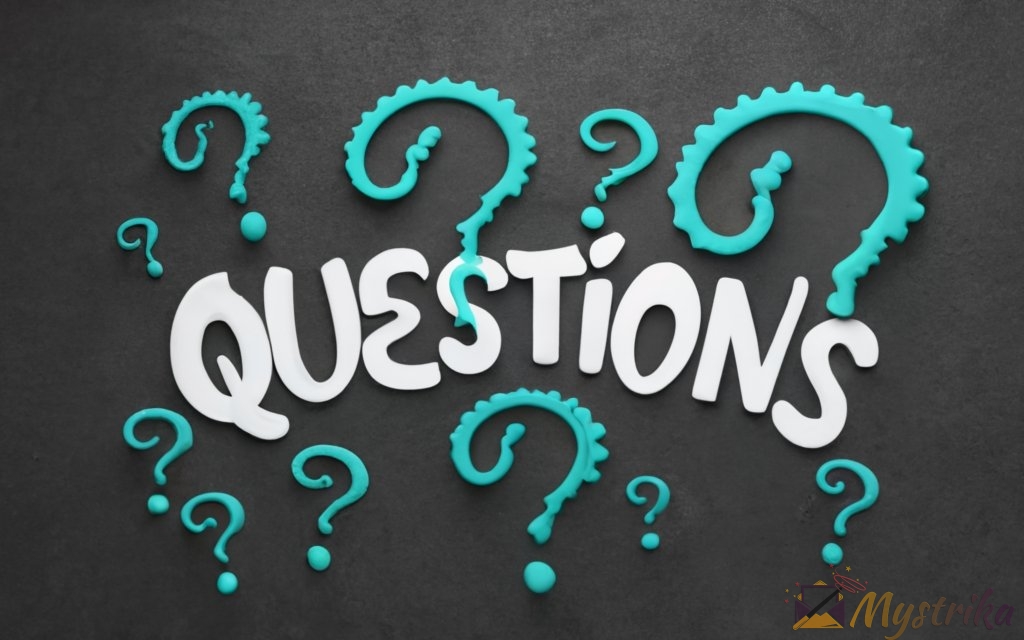
Common Questions about Brand Association
Let’s explore some frequently asked questions to develop your knowledge of brand associations further:
How do brand associations develop?
Brand associations form through repeated exposure to marketing, brand experiences, and overall awareness. This happens through direct and indirect means like:
- Advertising campaigns repeatedly linking concepts to the brand through messaging, imagery, characters, etc.
- Publicity (earned media), sponsorships, and event partnerships fusing the brand with something newsworthy.
- Social media conversations sharing how the brand fits into cultural narratives.
- Physical brand elements like logos, sounds, scents, textures, and more building mental recall.
- Shopping experiences interacting with retail environments, salespeople, and sensory elements.
- Testing and using the product or service, evaluating its benefits and attributes first-hand.
- Recommendations from others sharing thoughts influenced by their own brand associations.
- General brand perception and halo effect based on visibility and current image.
So brand associations strengthen through layered positive and consistent exposures across marketing, social buzz, physical interactions, product experiences, and vicarious impressions.
How are brand associations measured?
Brand associations are measured both qualitatively and quantitatively:
Qualitative research like focus groups, interviews, and community commentary analysis looks at the descriptive words, emotions, and connections people voice regarding a brand. Researchers code these patterns into broader themes and association categories.
Quantitative surveys present respondents with brand names and have them select attributes, benefits, and personality traits. Or they ask open-ended questions about any top-of-mind associations. Higher frequency associations are quantified.
Brand maps visually plot how strongly respondents associate specific attributes and benefits with a brand versus competitors. Brands aim for unique and “ownable” associations versus cliché or generic associations.
Brand trackers routinely measure changes in brand associations over time, especially after major marketing efforts, brand scandals, new product launches, and other pivotal brand events. Shifts reveal impact.
How can negative brand associations be changed?
First, understand what caused the negative association so you can address the root issue. Analyze whether it was a temporary marketing misstep or a more complex, systematic brand failure needing change.
Significant brand rehabilitations take time and concentrated effort. But associations can change through actions like:
- Publicly acknowledge the issue and apologize if consumers were wronged. Don’t try to deny or downplay concerns.
- Correct product flaws, overhaul policies, improve workplace culture, or make other substantive fixes to the problem that created distrust.
- Proactively discuss how your brand will move forward, treat customers better, retrain employees, and monitor for recurrences.
- Gradually shift messaging and visuals to reinforce new desired associations. For example, emphasize quality control and safety measures for brands with past contamination issues.
- Influence associations through new partnerships, sponsorships, and PR that repaint your brand’s image.
- Let past negative press fade from consumers’ immediate memory while crowding it out with an influx of positive news.
Remaining consistent and committed to real change is crucial. Consumers will otherwise see right through disingenuous rebranding attempts.
How important are brand associations in marketing?
Brand associations are enormously impactful in shaping consumer behavior and marketing success. Brands with strong, positive associations benefit through:
- Increased brand awareness and recall – Associations make brands pop into minds faster when consumers have a need.
- Guiding purchasing criteria – Consumers will look for brands matching the associations they desire – like safety, luxury, or reliability.
- Favorability – Positive associations cast brands in a good light so consumers prefer them over less associated competitors.
- Emotional connections – Associations linking to deeper meanings, values, and identities build bonds beyond a simple transaction.
- Willingness to pay premiums – Consumers will pay more for brands strongly linked to quality, status, and other differentiators.
- Loyalty – Meeting expectations created through associations satisfies customers and earns repeat business.
Associations influence consideration, choice, satisfaction, and lifetime value. Shaping them is foundational to branding.
Can brand associations change over time?
Brand associations absolutely evolve and change over time as consumer values, culture, and brand experiences shift. Consider how perceptions have changed for brands like:
- Oil companies – Once seen as innovative have become associated with greed and environmental destruction.
- Tobacco brands – Once glamorized now face associations with addiction and health risks.
- Tech brands – Facebook and Google once tied to connectivity now associated more with privacy threats.
- Tesla – Originally a niche upstart now linked to mainstream electric vehicle adoption.
- Tide – Moved from purely functional associations to entertainment via inventive Super Bowl ads.
- Old Spice – Transformed from a legacy brand associated with older men to hyper-viral marketing and youth appeal.
Brands cannot rest on their laurels. They must continually resurvey the landscape and adapt branding to maintain positive, relevant associations that attract the target audience.
Powerful brand associations are shaped day by day, campaign by campaign. With smart brand tracking, they reveal what’s working and what needs rethinking as consumer perspectives evolve.
Other Relevant Questions
What is brand association?
Brand association refers to the mental connections and relationships consumers make with a brand. It’s what comes to mind when they think of your company. Positive associations influence brand choice and loyalty.
Why are brand associations important?
Brand associations directly impact marketing success by boosting brand awareness, guiding purchase criteria, creating positive brand image, allowing premium pricing, and building emotional connections.
How do brand associations develop?
Associations form through repeated brand exposures like advertising, social media, product experiences, retail environments, and earned media. Consistent, strategic messaging and experiences shape associations.
What are some types of brand associations?
Common associations include attribute, benefit, interest, personality, attitude, and endorsement-based. Attribute associations link to descriptive product qualities while emotional benefits create feeling-driven connections.
How are brand associations measured?
Quantitative surveys, brand maps, and brand trackers reveal association strength and shifts over time. Qualitative research provides context on descriptive associations mentioned.
What are some examples of powerful brand associations?
Apple represents innovation, Nike athletics and achievement, Coca-Cola happiness and refreshment. Patagonia is tied to eco-consciousness while Starbucks represents relaxing “third place” experiences.
How can negative brand associations be changed?
Address root issues, apologize, visibly improve, then gradually reshape associations through consistent messaging and positive partnerships that repaint brand perceptions.
How can I build strong brand associations?
Strategically link your brand to target concepts across touchpoints through aligned messaging, sensory branding, public relations moments, influencer marketing, memorable storytelling, and delivering on your brand promise consistently.
Do brand associations change over time?
Yes, brand associations evolve as consumer values and culture change. Brands must continually resurvey the landscape and adapt branding to maintain relevant, positive associations.
Associations hold influence, so astute brand managers will stay on top of nurturing them intentionally.

Key Takeaways
Brand associations have an incredibly influential, yet often underestimated impact on consumer decisions and impressions. Savvy marketers realize associative meanings are the invisible force shaping brand image and equity.
By consistently linking your brand to strategic concepts, emotions, values, and personalities, you direct how consumers perceive you. Positive, strong associations make your brand stand out favorably in the minds of prospects.
Brand associations manifest across many forms like attributes, benefits, interests, attitudes, and endorsements. The most powerful associations are tailored to resonate with your unique target audience while maximally differentiating you from competitors.
Shaping successful associations requires in-depth customer insights coupled with coordinated execution across every touchpoint. You must reinforce coherent messaging and experiences aligned with your brand identity through all interactions.
Monitor quantitatively how marketing efforts strengthen or weaken brand associations over time. Track awareness studies and brand equity metrics as measures of connection effectiveness.
When negative associations surface, address the root cause. Then gradually reshape perceptions through improved consistency, transparent communications, and living your brand values.
While associations may evolve across generations, proactively manage them to keep your brand relevant. Ultimately, brand associations trigger the thoughts, feelings, memories, and expectations that fuel brand love.
Consumers are vastly more likely to purchase and advocate for brands with positive meanings stored in their memory networks. So take charge of your brand narrative by strategically embedding associations that make your brand stand for something meaningful.
The most iconic brands like Apple and Nike achieved phenomenal success by burrowing into consumers’ minds as symbols of innovation, self-actualization, and achievement. Pursue your own distinctive niche in culture.
Immerse yourself in your customers’ worlds to uncover which associations would uniquely captivate them, fulfill unmet needs, and form lasting connections. By weaving brand stories that stick, you earn a coveted place in their hearts, minds, and wallets for years to come.
Summary on Brand Association
- Brand association refers to the mental connections and relationships consumers form with a brand. Positive, strong associations directly impact marketing success.
- Brand associations develop through repeated, consistent exposures across all brand touchpoints and experiences.
- Types of associations include attribute, benefit, interest, personality, attitude, and endorsement-based. Strategic associations are tailored to your audience and differentiators.
- Brand associations boost awareness, drive purchase decisions, build emotional connections, and allow brands to charge premiums. Tracking studies reveal their business impact.
- Examples like Apple, Nike, Coca-Cola, and Patagonia show how iconic brands build associative meanings consumers instantly recognize.
- Proactively shape associations through brand identity alignment, sensory branding, influencer partnerships, public relations moments, and powerful storytelling across channels.
- Monitor brand associations quantitatively over time. Address root causes if negative associations emerge. Continually evolve associations to remain relevant as consumer values change.
- In consumers’ minds, strong brand associations manifest as gut feelings guiding their brand affinity and choice. Manage your brand narrative strategically to stand for something meaningful.

